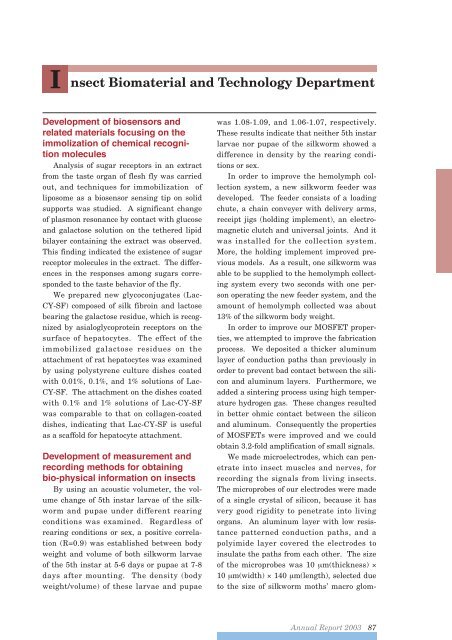You also want an ePaper? Increase the reach of your titles
YUMPU automatically turns print PDFs into web optimized ePapers that Google loves.
Insect Biomaterial and Technology DepartmentDevelopment of biosensors andrelated materials focusing on theimmolization of chemical recognitionmoleculesAnalysis of sugar receptors in an extractfrom the taste organ of flesh fly was carriedout, and techniques for immobilization ofliposome as a biosensor sensing tip on solidsupports was studied. A significant changeof plasmon resonance by contact with glucoseand galactose solution on the tethered lipidbilayer containing the extract was observed.This finding indicated the existence of sugarreceptor molecules in the extract. The differencesin the responses among sugars correspondedto the taste behavior of the fly.We prepared new glycoconjugates (Lac-CY-SF) composed of silk fibroin and lactosebearing the galactose residue, which is recognizedby asialoglycoprotein receptors on thesurface of hepatocytes. The effect of theimmobilized galactose residues on theattachment of rat hepatocytes was examinedby using polystyrene culture dishes coatedwith 0.01%, 0.1%, and 1% solutions of Lac-CY-SF. The attachment on the dishes coatedwith 0.1% and 1% solutions of Lac-CY-SFwas comparable to that on collagen-coateddishes, indicating that Lac-CY-SF is usefulas a scaffold for hepatocyte attachment.Development of measurement andrecording methods for obtainingbio-physical information on insectsBy using an acoustic volumeter, the volumechange of 5th instar larvae of the silkwormand pupae under different rearingconditions was examined. Regardless ofrearing conditions or sex, a positive correlation(R=0.9) was established between bodyweight and volume of both silkworm larvaeof the 5th instar at 5-6 days or pupae at 7-8days after mounting. The density (bodyweight/volume) of these larvae and pupaewas 1.08-1.09, and 1.06-1.07, respectively.These results indicate that neither 5th instarlarvae nor pupae of the silkworm showed adifference in density by the rearing conditionsor sex.In order to improve the hemolymph collectionsystem, a new silkworm feeder wasdeveloped. The feeder consists of a loadingchute, a chain conveyer with delivery arms,receipt jigs (holding implement), an electromagneticclutch and universal joints. And itwas installed for the collection system.More, the holding implement improved previousmodels. As a result, one silkworm wasable to be supplied to the hemolymph collectingsystem every two seconds with one personoperating the new feeder system, and theamount of hemolymph collected was about13% of the silkworm body weight.In order to improve our MOSFET properties,we attempted to improve the fabricationprocess. We deposited a thicker aluminumlayer of conduction paths than previously inorder to prevent bad contact between the siliconand aluminum layers. Furthermore, weadded a sintering process using high temperaturehydrogen gas. These changes resultedin better ohmic contact between the siliconand aluminum. Consequently the propertiesof MOSFETs were improved and we couldobtain 3.2-fold amplification of small signals.We made microelectrodes, which can penetrateinto insect muscles and nerves, forrecording the signals from living insects.The microprobes of our electrodes were madeof a single crystal of silicon, because it hasvery good rigidity to penetrate into livingorgans. An aluminum layer with low resistancepatterned conduction paths, and apolyimide layer covered the electrodes toinsulate the paths from each other. The sizeof the microprobes was 10 µm(thickness) ×10 µm(width) × 140 µm(length), selected dueto the size of silkworm moths’ macro glom-<strong>Annual</strong> <strong>Report</strong> <strong>2003</strong> 87













